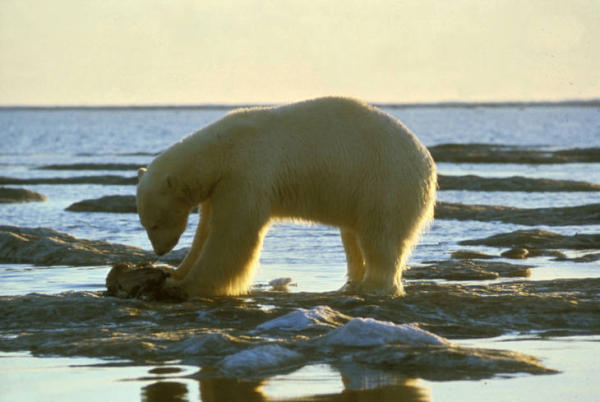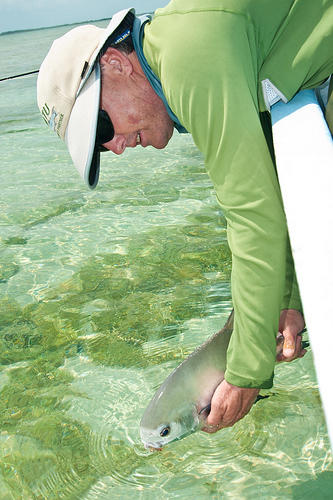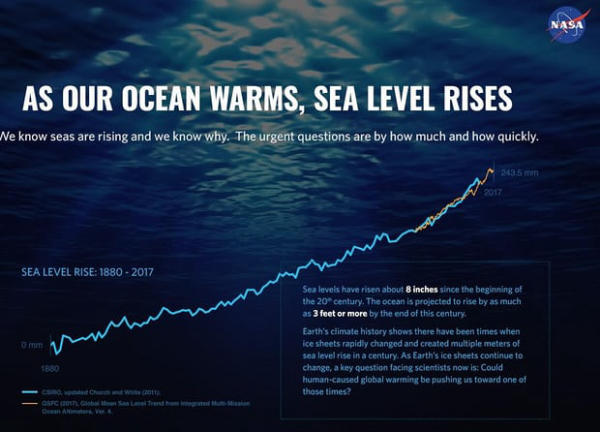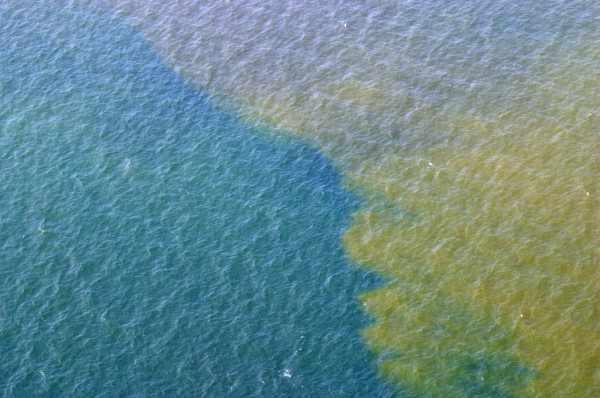This is the second in a series of three features on Climate Change or Global Warming as it affects anglers, boaters and outdoors families as well as the industries that support them. Today, we look at the evidence that seems to indicate the process is underway, and that we humans may have a lot to do with it--admittedly a point of contention among many Americans today.
Learning about Global Warming is like hearing you need heart surgery, very unwelcome news. We naturally want a second opinion, a mulligan, a do-over.
I've been a bit of a foot dragger to the climate change party, but better to be a foot dragger than a knuckle-dragger, I suppose--I learn slowly, but I am capable of learning.
It's true that some GW believers are as annoying as chigger bites in church, and a few of the most opinionated, sky-is-falling faithful have very little idea of what they are talking about. But the same can be said of some of the "deniers", those of us who just don't want to hear it.
From this end of the boat, it seems like we don't need sides or parties in the discussion, we simply need to look at the facts and then try to make some sense of them, mutually. Maybe take a page from the "No Yelling School of Fishing Instruction", a ladies' fishing workshop in Florida, listen to each other and learn together.
Hunters and anglers are well aware of the success of scientific game and fish management--provide good habitat and reasonable harvest laws and fish and wildlife thrive. Climate science is an extension of this concept, to all species including ourselves. Seems like something all of us need to take time away from relining the reels and sharpening the broadheads to register, doesn't it?
Could the Big GW Be a Hoax?
It's certainly possible for a few scientists to let their political leanings or financial influences affect their reports, in either direction, or to be just plain wrong. Remember, even Einstein was found to be wrong about quantum physics and black holes.
But to assume that thousands of researchers, worldwide, in dozens of nations at hundreds of universities and government agencies and private think tanks are all in collusion to perpetrate this massive hoax--that they all, doing their own research, coming up with their own data, agree to bend it so that it looks like Climate Change is happening when it's not--that just does not work for me, nor can I imagine that it works for most reasonable people.
To be sure, there are those in the media who have pretty obviously decided to make Climate Change their life's work, and like a man with a hammer, are constantly in search of ever hotter nails. The recent flap over National Geographic's use of a decrepit polar bear photo to "prove" Global Warming is wiping out the species is an egregious example, from a respected source many of us have long trusted. You may also remember the "last ice floe" bear-drowning photo from a few years previous, this for a species that has been known on several occasions to swim from Greenland to Iceland, over 700 miles!
Polar bears are not snowflakes, fortunately--they do not melt under stress (nor move in with their parents when they turn 30) but adapt. Instead of the 12,000 or so there were across the Arctic in 1970, there are now somewhere north of 25,000 and the population continues to grow in many areas, as observed by U.S. Fish and Wildlife surveys in cooperation with other nations which claim part of the Arctic. Whether that continues as things get warmer still remains to be seen, but so far so good for the bears. (Not so good for the seals and walruses they eat, though--Nature is not for sissies.)

I also understand those--including some of my snooking buddies and deer camp cronies--who feel that current record rains, record heat spells and fires, record high tides being repeated month after month could be a glitch in the long sweep of time, just a speed bump if looked at in the march of centuries. (We don't talk about the march of centuries in the skinning shed, exactly, but that's the gist of the conversation.)
Let the Data Lead the Way
"Let the data lead the way," Dr. Aaron Adams, Director of Science for the Bonefish & Tarpon Trust in Coral Gables, FL, likes to say.
The idea, common among scientists, is that you avoid forming a theory and then trying to prove you are "right", but instead look at the data research brings you and from that form your theories, changing them if the data changes.
As an example, Adams and others with B&TT noted a few years back that permit are spawning a month earlier than they did 20 years ago in the keys, now starting in April as proven by sampling of egg-laden fish, despite common knowledge among all expert permit anglers that the spawn started in May.

Dr. Aaron Adams of the Bonefish and Tarpon Trust is not only one of the world's top researchers on flats species, he's also an outstanding fly-rod angler. As a scientist, his mantra is "Let the data lead the way." (Photo Credit Aaron Adams)
|
One possible cause of the earlier spawn is likely because the water warms sooner than it used to. But whatever the reason, Adams and colleagues campaigned successfully with the Florida Fish & Wildlife Conservation Commission for an earlier start to the no-harvest season in those waters, thus protecting one of the great flats fisheries anywhere.
Adams is not a glass-tower egghead in any way--he's one of the better flyrod flats anglers on the planet. It's an example of the sort of information-laden push that anglers, conservationists and the industry can give government to get things going in the right way, for all of us. (Push is the wrong word, maybe--it's more education; most people in a free society, once they understand serious problems, are pretty quick to seek solutions--even politicians.)
So What's Happening?
What does Global Warming mean in practical terms, stuff that we can see with our own eyes, right now?
It might mean more mosquitoes and no-see-ums on Lostman's River . . . scratch that, there's no room for more 'skeeters and no-see-ums on Lostman's. But you get my drift. Warmer weather equals more bugs, including nasty ones like Zika mosquitoes and Lyme disease ticks.
Sea level rise? There have always been flood tides that went into the streets in south Florida--get a full moon and strong, sustained winds and the mullet come swimming up through the storm drains. To folks who have only lived there a few years, it seems clear evidence that global warming is suddenly at their doorstep, while Crackers (in the good sense of Old Florida folks, not the bad sense of hostile Caucasians) take off their shoes and wade to where ever they're going.
But clearly, these events are getting more frequent and more severe; the average height of the sea is absolutely rising, and so the high tide events cause more problems for more people.

In the past century, the average sea level has risen 9 inches in Key West according to NASA--we have to accept that on faith because none of us were around in 1918. But in a little more than the last 20 years, it has risen another 3 inches. Obviously, the rate of increase has jumped--if you've been there in recent decades, you've seen the difference. And the rate of increase, is increasing.
By 2060, it’s predicted to rise another 2 feet, which is a big problem on low, flat and heavily-populated islands like these. I love bonefish, but I don't want them swimming under my favorite stool in Sloppy Joe's.
Why is the water coming up abruptly? The data says it's because the relatively rapid increase in global temperature is causing the polar ice caps, as well as high country glaciers everywhere, to melt, run into the sea and push the levels up. I've been to Glacier National Park several times in recent years and they ain't kidding--the glaciers are melting down faster than the value of Facebook. They're down 40 percent in the last 50 years according to the U.S. Geological Survey, which watches them via satellite.
A Thermal Blanket on the Planet
And the cause is most likely to be the rapid increase in CO-2 and methane, both produced by human activities in copious amounts in the last 150 years, and perhaps now reaching critical mass. Researchers have determined the gases form a blanket over our atmosphere and prevent the heat of the sun from escaping at the normal rate, thus the temperatures are going up.
There's no question about this increase in temperature, though we might argue about the causes or the duration. According to NASA, the average global temperature on Earth has increased by about 0.8° Celsius (1.4° Fahrenheit) since 1880. Two-thirds of the warming has occurred since 1975, at a rate of roughly 0.15-0.20°C per decade.
That doesn't sound like a lot considering we typically see a 30-degree daily fluctuation in the tail of the Appalachians where I live, and even more in some high-desert areas of the west.
But meteorologists with NASA say that the average increase is a point of concern. This ancient evidence from sea floor and glacial cores reveals that current warming is occurring roughly ten times faster than the average rate of normal ice-age-recovery warming that's been going on for the last 9,000 years or so.
Just a little change in the average temperature has a big effect on our weather: The five warmest years on record have occurred since 2010. Not only was 2016 the warmest year on record, but eight of the 12 months that make up the year — from January through September, with the exception of June — were the warmest on record for those respective months according to NASA.
As this is written, 2018 is setting records all over the American west as well as across much of the northern hemisphere. The continental U.S. had its hottest May and the third-hottest June since temperature records have been kept. Japan has had triple-digit temperatures, killing at least 86 people. Record temperatures were also reported on the edge of the Sahara and above the Arctic Circle.
Natural Warming Versus Man-Made Increases
We should stop to note here, though, that according to the scientists, we are still coming out of the last ice age which ended about 10,000 years ago, and so we naturally see glaciers and ice caps melting and sea level creeping upward as a result. In fact, they tell us there have been numerous ice ages and "interglacial" warm periods over the last 2.6 million years, obviously not human-caused, and in each case the sea level went way down as snow and ice accumulated, and then way up as it melted--sometimes as much as 300 feet over current levels.
We know this happened because there are a whole lot of fossil sea creatures in the strata of Iowa and Arkansas. The water also went WAAAY down for thousands of years during the cold cycles as water was taken up in glaciers more than 2 miles thick. Those of you who have fished the edge of the continental shelf in the Gulf of Mexico, from 80 to 100 miles off the current shoreline, have been fishing what was then the edge of North America. So fluctuation in temperature and resulting sea level is nothing new. It's the rapid increase in the last 50 years or so that has the climate watchers concerned.
Bad JuJu for the Future
Nature is a coordinated dance, and big changes in climate patterns will assuredly impact fish and wildlife all over the world. But there are going to be far more serious consequences than a loss of quality fishing and hunting and negative impacts on outdoors industry jobs if the worst of the predictions come anywhere near true, of course.
A lot of Florida's coastline will flood, permanently, including some of the most high-dollar real-estate on the planet. Louisiana's delta country, already in trouble because of the sinking terrain associated with loss of sediment from the dammed Mississippi and the ground water loss and channelization from oil development, is watching the water come up at a rate close to 10 mm a year, several times faster than in areas where sea-level rise alone is causing the increase. If the rate continues, the famed redfish and trout marshes there could be only a memory in a few decades--and future hurricanes are likely to do even worse damage to New Orleans and surrounding communities.
Tropical storms are likely to get bigger than ever before--meteorologists are right now talking about adding a Category 6 to the hurricane scale to account for the increasing number of storms with winds approaching 200 mph. In the west, the already horrendous fires will probably get even bigger and more frequent, making much of the mountain country unlivable not only for humans but for blacktails, elk, mule deer and much else. A little fire is good for wildlife habitat, but fires covering tens of thousands of acres, not so much.
America will get off easy compared to many of the poorer nations around the world, where almost all the available land is only a few feet above sea level, and where entire populations may have to pick up and move . . . to where? The Syrian immigrant crisis gave us a taste of what this could be like, and like that exodus, it's likely to reach far beyond being a regional problem.
Red tide and other algal blooms are not caused by hotter water, scientists tell us, but the heat definitely makes them more intense and longer-lasting. Florida is now locked in the longest red tide in modern history, with millions of gamefish including snook, tarpon and Goliath grouper dying along the southwest coast.

And blue-green algae--primarily caused by excess nutrients but again extended by hot weather-- is ruining the fishing as well as the property values in Indian River Lagoon around Stuart, where the blooms are sometimes thick as mud. The area was once famed for producing 30-inch seatrout in ankle-deep water, as well as tons of lunker snook. Florida Sportsman Magazine, a leader in conservation issues as well as an angler advocate, was recently pushed out of its waterfront offices by a noxious, choking surge of this environmental guacamole.
So what can be done about all this, if anything? We'll take a look at that in Part 3, tomorrow.
-- Frank Sargeant, Editor
The Fishing Wire
(We welcome comments on this series. Please respond to Frankmako1@gmail.com.)